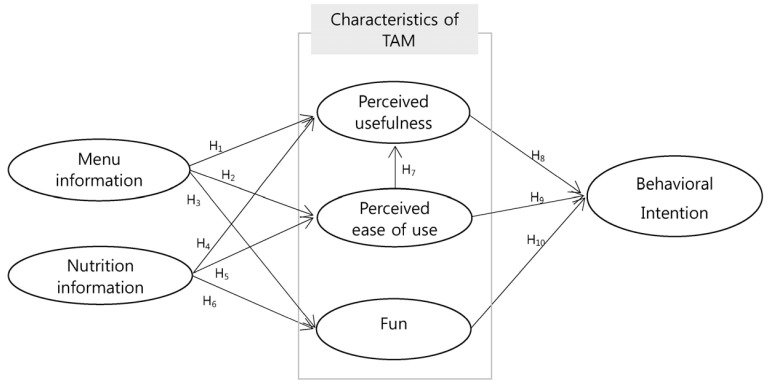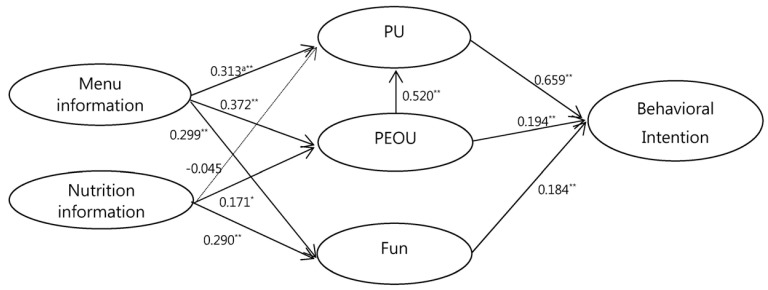Nutr Res Pract.
2020 Apr;14(2):167-174. 10.4162/nrp.2020.14.2.167.
Impacts of menu information quality and nutrition information quality on technology acceptance characteristics and behaviors toward fast food restaurants' kiosk
- Affiliations
-
- 1Department of Food & Nutrition, Institute of Symbiotic Life-TECH, College of Human Ecology, Yonsei University, 50 Yonsei-ro, Seodaemun-gu, Seoul 03722, Korea. sham2@yonsei.ac.kr
- KMID: 2471885
- DOI: http://doi.org/10.4162/nrp.2020.14.2.167
Abstract
- BACKGROUND/OBJECTIVES
With the advances in technologies, self-service kiosks at foodservice operations are becoming a new way of service provision. This study examined the relationships among the menu information quality, nutrition information quality, technology acceptance characteristics, and customer behavioral intention toward the kiosks in fast food restaurants.
SUBJECTS/METHODS
A survey with a self-administered method was distributed online and offline. The sample consisted of customers who had used the kiosks at fast food restaurants in the last six months prior to the survey. The study hypotheses were tested by applying structural equation modeling.
RESULTS
Structural equation modeling revealed the positive impacts of menu information quality and nutrition information quality, technology acceptance characteristics, and behavioral intention toward kiosks at fast food restaurants. On the other hand, one hypothesis (Hypothesis 4) on the impact of nutrition information quality on the perceived usefulness was rejected.
CONCLUSION
The study is the first to investigate nutrition and menu information at foodservice kiosks and relate them to technology acceptance. The study is very timely and adequate in the time of the 4th industrial revolution. The critical importance of the presentation of nutrition information and menu information at the kiosks at fast food restaurants was verified. The academic and industrial implications of the study findings were discussed.
Keyword
MeSH Terms
Figure
Reference
-
1. Choi HS, Jo JE, Ham SP. Self-Service check-in kiosk use behaviour: an application of technology acceptance model. J Tourism Leis Res. 2009; 21:295–315.2. Tice C. How restaurants are using technology to deliver better customer service [Internet]. Jersey City (NJ): Forbes;2012. cited 2018 October 12. Available from: http://www.forbes.com/sites/caroltice/2012/12/07/how-restaurants-are-using-technology-to-deliver-better-customer-service/#154baelf6b76.3. Dixon M, Kimes SE, Verma R. Customer preferences for restaurant technology innovations. Cornell Hosp Rep. 2009; 9:6–16.4. Lee IS, Na YA, Yoon HH. The effects of foodservice consumer's perceived technology-based self-service characteristics on satisfaction and purchase intention: with a focus on an online menu ordering system. Korea J Tourism Hosp Res. 2013; 27:85–100.5. Jeong SW. The effect of perceived reliability of self-service kiosk on the intention to use [master's thesis]. Seoul: Konkuk University;2018.6. Song MH. A proposal of multimedia menu system for drive-thru. J Basic Des Art. 2002; 3:87–97.7. Hafner J, Limbachia D. McDonald's: You buy more from touch-screen kiosks than a person. So expect more kiosks [Internet]. Tysons Corner (VA): USA today;2018. cited 2019 November 11. Available from: https://www.usatoday.com/story/money/nation-now/2018/06/07/mcdonalds-add-kiosks-citing-better-sales-over-face-face-orders/681196002/.8. Kim YK. Kiosk to accelerate unattended trend [Internet]. Daejeon: ITTP;2017. cited 2018 November 18. Available from: http://www.itfind.or.kr/admin/getFile.htm?identifier=02-001-170404-000003.9. Kimes SE, Collier JE. How customers view self-service technologies [Internet]. Cambridge (MA): MIT Sloan;2015. cited 2018 October 20. Available from: http://sloanreview.mit.edu/article/how-customers-view-self-service-technologies/.10. Beldona S, Buchanan N, Miller B. Exploring the promise of e-tablet restaurant menus. Int J Contemp Hosp Manag. 2014; 26:367–382.
Article11. Davidge D. 4 reasons why self-service enhances customer experience [Internet]. Seattle (WA): AnswerDash;2016. cited 2018 October 12. Available from: http://www.answerdash.com/blog/4-reasons-why-self-service-enhances-the-way-customers-engage-with-your-services.12. Dabholkar PA, Bagozzi RP. An attitudinal model of technology-based self-service: moderating effects of consumer traits and situational factors. J Acad Mark Sci. 2002; 30:184–201.
Article13. Hilton T, Hughes T, Little E, Marandi E. Adopting self-service technology to do more with less. J Serv Mark. 2013; 27:3–12.
Article14. Wei W, Torres E, Hua N. Improving consumer commitment through the integration of self-service technologies: a transcendent consumer experience perspective. Int J Hosp. 2016; 59:105–115.
Article15. Kimes SE. The role of technology in restaurant revenue management. Cornell Hosp Q. 2008; 49:297–309.
Article16. Yepes MF. Mobile tablet menus: attractiveness and impact of nutrition labeling formats on millennials' food choices. Cornell Hosp Q. 2015; 56:58–67.17. Pomeranz JL, Brownell KD. Legal and public health considerations affecting the success, reach, and impact of menu-labeling laws. Am J Public Health. 2008; 98:1578–1583. PMID: 18633081.
Article18. Drichoutis AC, Lazaridis P, Nayga RM. Consumers' use of nutritional labels: a review of research studies and issues. Acad Mark Sci Rev. 2006; 9:93–118.19. Jeong YS, Ham SO, Yang IS, Kim HY. Customer awareness of and satisfaction with menu labeling for restaurants. Korean J Hosp Tourism. 2014; 23:221–237.20. Burton S, Creyer EH, Kees J, Huggins K. Attacking the obesity epidemic: the potential health benefits of providing nutrition information in restaurants. Am J Public Health. 2006; 96:1669–1675. PMID: 16873758.
Article21. Kim K, Kim M, Lee KE. Assessment of foodservice quality and identification of improvement strategies using hospital foodservice quality model. Nutr Res Pract. 2010; 4:163–172. PMID: 20461206.
Article22. Tandon PS, Zhou C, Chan NL, Lozano P, Couch SC, Glanz K, Krieger J, Saelens BE. The impact of menu labeling on fast-food purchases for children and parents. Am J Prev Med. 2011; 41:434–438. PMID: 21961472.
Article23. Auchincloss AH, Mallya GG, Leonberg BL, Ricchezza A, Glanz K, Schwarz DF. Customer responses to mandatory menu labeling at full-service restaurants. Am J Prev Med. 2013; 45:710–719. PMID: 24237912.
Article24. Ellison B, Lusk JL, Davis D. Looking at the label and beyond: the effects of calorie labels, health consciousness, and demographics on caloric intake in restaurants. Int J Behav Nutr Phys Act. 2013; 10:21. PMID: 23394433.
Article25. Lim HJ, Kim MJ, Kim KW. Factors associated with nutrition label use among female college students applying the theory of planned behavior. Nutr Res Pract. 2015; 9:63–70. PMID: 25671070.
Article26. Ahn JY, Park HR, Lee K, Kwon S, Kim S, Yang J, Song KH, Lee Y. The effect of providing nutritional information about fast-food restaurant menus on parents' meal choices for their children. Nutr Res Pract. 2015; 9:667–672. PMID: 26634057.
Article27. Lee JE, Lee DE, Kim K, Shim JE, Sung E, Kang JH, Hwang JY. Development of tailored nutrition information messages based on the transtheoretical model for smartphone application of an obesity prevention and management program for elementary-school students. Nutr Res Pract. 2017; 11:247–256. PMID: 28584582.
Article28. Lee K, Lee Y. Parents' meal choices for their children at fast food and family restaurants with different menu labeling presentations. Nutr Res Pract. 2018; 12:243–250. PMID: 29854330.
Article29. HealthCare.gov (US). Patient protection and affordable care act [Internet]. Baltimore (MD): HealthCare.gov;2010. cited 2019 November 17. Available from: https://www.healthcare.gov/glossary/patient-protection-and-affordable-care-act.30. U.S. Food & Drug Administration. Changes to the nutrition facts label [Internet]. U.S. Food & Drug Administration;2017. cited 2019 November 17. Available from: https://www.fda.gov/Food/GuidanceRegulation/GuidanceDocumentsRegulatoryInformation/LabelingNutrition/ucm385663.htm#dates.31. Department of Health (UK). Public health responsibility deal: food pledges. [Internet]. London: Department of Health;2011. cited 2019 November 17. Available from: https://responsibilitydeal.dh.govuk/food-pledges.32. de Oliveira RC, da Costa Proenca RP, de Salles RK. The right to food and nutrition information in restaurants: a review/O direito a informacao alimentar e nutricional em restaurantes: uma revisao. Dementia. 2012; 7:47.33. European Food Information Council. Global update on nutrition labeling [Internet]. Brussels: European Food Information Council;2016. cited 2019 November 17. Available from: https://www.eufic.org/images/uploads/files/ExecutiveSummary.pdf.34. Ministry of Food and Drug Safety (KR). Korean government has enacted the special act on Children's food safety and nutrition [Internet]. Cheongju: Ministry of Food and Drug Safety;2016. cited 2019 November 17. Available from: http://www.kfda.go.kr/nutrition/index.do.35. Jeong JY, Ham S. Application of the Health Belief Model to customers' use of menu labels in restaurants. Appetite. 2018; 123:208–215. PMID: 29248690.
Article36. Ministry of Food and Drug Safety (KR). Source [Internet]. Cheongju: Ministry of Food and Drug Safety;2018. cited 2018 November 20. Available from: mfds.go.kr/index.do.37. Ministry of Health and Welfare (KR). The 2nd national nutrition management basic plan (2017~2021) [Internet]. Cheongju: Ministry of Health and Welfare;2017. cited 2018 November 23. Available from: http://www.mohw.go.kr/react/jb/sjb030301vw.jsp?PAR_MENU_ID=03&MENU_ID=0319&CONT_SEQ=340125&page=1.38. Adams DA, Nelson RR, Todd PA. Perceived usefulness, ease of use, and usage of information technology. Manage Inf Syst Q. 1992; 16:227–247.39. Hendrickson AR, Massey PD, Cronan TP. On the test-retest reliability of perceived usefulness and perceived ease of use scales. Manage Inf Syst Q. 1993; 17:227–230.
Article40. Igbaria M, Parasuraman S, Baroudi JJ. A motivational model of microcomputer usage. J Manage Inf Syst. 1996; 13:127–143.
Article41. Davis FD. Perceived usefulness, perceived ease of use, and user acceptance of information technology. Manage Inf Syst Q. 1989; 13:319–340.
Article42. Shim HS, Han SR. Effects of TR and consumer readiness on SST usage motivation, attitude and intention. Asia Mark J. 2012; 14:25–48.43. Moon HY. A study on restaurant customer-based IT services: focused on technology acceptance model. J Tourism Leis Res. 2018; 30:325–339.44. Heijden H. User acceptance of hedonic information systems. Manage Inf Syst Q. 2004; 28:695–704.45. Oh H, Jeong M, Baloglu S. Tourists' adoption of self-service technologies at resort hotels. J Bus Res. 2013; 66:692–699.
Article46. Ku EC, Chen CD. Fitting facilities to self-service technology usage: evidence from kiosks in Taiwan airport. J Air Transp Manage. 2013; 32:87–94.
Article47. Venkatesh V, Morris MG. Why don't men ever stop to ask for direction? Gender, social influence, and their role in technology acceptance, and usage behavior. Manage Inf Syst Q. 2000; 24:115–139.48. Davis FD, Bagozzi RP, Warshaw PR. User acceptance of computer technology: a comparison of two theoretical models. Manage Sci. 1989; 35:982–1003.
Article49. Ajzen I, Fishbein M. Predicting and understanding consumer behavior: attitude-behavior correspondence. Understanding Attitudes and Predicting Social Behavior. Englewood Cliffs (NJ): Prentice-Hall;1980. p. 148–172.50. Burt RS. Interpretational confounding of unobserved variables in structural equation models. Sociol Methods Res. 1976; 5:3–52.
Article51. Anderson JC, Gerbing DW. Structural equation modeling in practice: a review and recommended two-step approach. Psychol Bull. 1988; 103:411–423.
Article52. Kline RB. Software review: software programs for structural equation modeling: AMOS, EQS, and LISREL. J Psychoed Assess. 1998; 16:343–364.
Article
- Full Text Links
- Actions
-
Cited
- CITED
-
- Close
- Share
- Similar articles
-
- Influence of Ordering Kiosk Nutrition Information Transparency and Information Quality on the Customer Behavioral Intention in Fast Food Restaurants
- The Recognition and Requirement of Nutrition Labeling in Fast-Food Restaurants
- Effect of Menu Calorie Labels on Menu Sales and Consumer's Recognition at a Korean Restaurant in a Hotel
- The Development of Website-based Food and Nutrition for Women
- The effect of providing nutritional information about fast-food restaurant menus on parents' meal choices for their children



